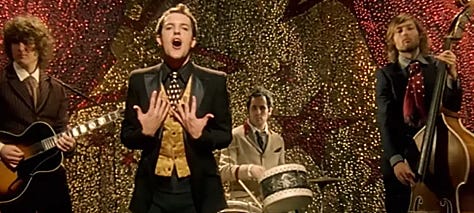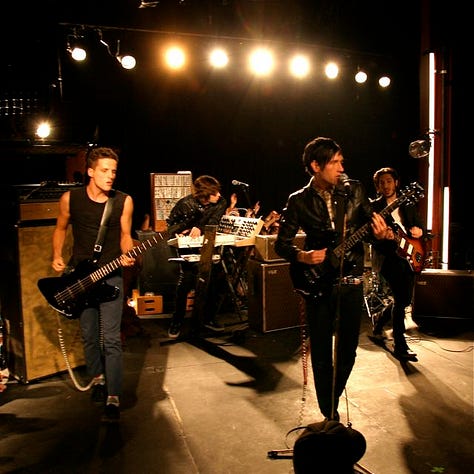New Wave’s Second Wind: A Revivalist’s Guide
How Franz, Flowers, and a Few Synths Rebooted the ’80s
PDFs ⧉ | Subscribe | Best of Year | By the Numbers | Themes | Styles | Artist Focus | Duran Duran
Audio Note: This audio version was AI-generated using a model of my voice, originally recorded during an old podcast. It's not perfect, but it helps bring the article to life.
Intro
As the ‘90s began, new wave and particularly synths were out-of-fashion. Many solid new wave bands were moved to obscurity (Human League), disbanded (Talking Heads) or survived by leaning on guitars and acoustic instruments (Depeche Mode, Duran Duran🔒, Adam Ant). My favorite bands of the ‘90s liked new wave music. No Doubt channeled Cyndi Lauper’s spunkiness and the ska rhythms of the Specials and the Jam. Green Day had a common ancestor with new wave in punk music. But come 2000, there was little joy in New Wave Land. The rock landscape was dominated by watered-down post-grunge bands and alt-metal. A new wave aficionado like me was crawling in the Sahara, until an oasis came in the form of new wave revival. Bands debuted that embraced new wave and post-punk. Melodies became peppier, and some synths even crawled out from the woodwork. While bigger in the UK, these new wave revival acts also got attention in the States from rock fans.
Franz Ferdinand
In 2004, my friend kept pushing Franz Ferdinand on me. Jaded by the rock scene after the ska revival faded in 2000 I reluctantly gave it a spin. Thankfully it was a breath of fresh air from the then-current post-grunge and alt-metal sludge.
While Franz Ferdinand borrowed heavily from post-punk, they also had a Duran Duran/Blondie flair to them. They had the jagged guitar stabs of Gang of Four melded with the rhythmic tension and lyrical surrealism of the Talking Heads. Their music has a danceable flair, channeling Duran Duran. The result is art school detachment, stylish irony, and post-punk minimalism. The band’s visual style - sharp jackets, haircuts you could set a watch to - echoed Duran Duran in restraint but felt totally 2000s.
Their self-titled debut was good for Platinum. Critics (like NME) praised the band for making art-rock feel sleek again. In their debut single Darts of Pleasure, Franz Ferdinand uses violent metaphors in a lust song. It didn’t go far but gave a taste for what was to come. Then came their breakout single (for them and the new wave revival movement) Take Me Out. In it, the narrator is lamenting that a bar hookup is not going to happen. But wait, is this instead about facing a firing squad (after all, the band’s named after an assassin)? This dark imagery brings to mind Joy Division. Another example is Michael, with its homoerotic tension and spiky groove.
After the similar follow-up You Could Have it So Much Better, Franz Ferdinand took a break then released Tonight. In it they tone down the Gang of Four melodies in favor of more beats, and (you guessed it) synths.
Franz Ferdinand - Take Me Out (listen on Spotify)
The Killers
Brandon Flowers and the Killers had a love for new wave music. Indeed, they were influenced by Duran Duran’s danceable rhythms and early New Order’s melancholy themes. What sets them apart from Franz Ferdinand and the Bravery is Flowers’ more anthemic style (like Springsteen).
Their debut, Hot Fuss, was a multi-platinum monster. Their debut single Mr. Brightside took a while to catch on but eventually became the to-this-day most well-known new wave revival song. Somebody Told Me has Duran Duran’s high drama in the bass and chorus while adding bombastic guitars (random fact: this song was in the 2006 movie Rocky Balboa). The urgency and mild paranoia of the lyrics and vocals of both songs recalls Depeche Mode.
In their next album Sam’s Town the Killers kept their synths, but started to wear their ambition on their sleeves. Brandon Flowers in particular had a theatrical, almost new romantic streak, with lyrics that leaned big and emotional. Also, they brought in a Bruce Springsteen story-telling style. On the new wave side of the coin, this is similar to the Boomtown Rats narrative approach. All These Things That I’ve Done stood out with its gospel-tinged climax and cryptic defiance. Read My Mind is also a solid single, with its anthemic intro synth. This was followed up by the more sonically diverse album Day & Age.
The Killers - Mr. Brightside (listen on Spotify)
The Bravery
The Bravery, like the Killers, had a Duran Duran and New Order pedigree. Their debut single dropped later, in early 2005. Maybe this is why Brandon Flowers of the Killers really disliked them, labelling them copycats. But in my opinion they had their own style. They leaned in more on New Order-esque rhythms more than Franz Ferdinand or the Killers, and weren’t afraid to go dark in their melodies, vocals and lyrics. The band leaned into a sleek, black-clad look—more underground club than arena-ready. While they had fewer albums, the Bravery’s music holds up and maintains cult status.
The melody to An Honest Mistake is a sped-up Blue Monday, all pulsing urgency and jittery charm. The album vocals remind me of Robert Smith from the Cure. Fearless shows they have some range: the vocals draw on the smoky, romantic and slightly-detached style of the Psychedelic Furs. The moody and variable synths recall the Cure and early Ultravox.
Songs like Believe and Time Won’t Let Me Go from their sophomore album The Sun and the Moon kept their moody tone alive. In their 3rd (and last) album Stir the Blood the Bravery lean heavier on their Depeche Mode influence as well. The song titles are macabre (I Am Your Skin, Slow Poison), reflecting their melodies, broodier synths and vocals.
The Bravery - An Honest Mistake (listen on Spotify)



Honorable Mention
While I mentioned three bands, there were many others. While they didn’t have chart success they are worth mentioning to show that the new wave revival bands drew from other influences:
Ladytron
named after a Roxy Music song, this all-female band took the detachment and minimalism of early synthpop and gave it a cold, fashion-forward gloss. Their influences (Human League and Gary Numan) are worn proudly but modernized with electroclash edge.
Metric
They picked up where the Missing Persons and Blondie left off. Their sound paired synth sheen with sharp guitars, and Emily Haines’ vocals delivered cool detachment with just enough bite.
Hot Hot Heat
Perfect if you need an Elvis Costello🔒 fix. Their nervy energy, jumpy keys, and rapid-fire lyrics channeled him and early XTC with a garage-band gleam.
Maxïmo Park
This band drew from the Jam and Magazine—tight guitars, intellectual lyrics, and urgency delivered with a Northern England accent and a poet’s flair.
Conclusion
The new wave revival faded gradually, unlike the sharp rejections of new wave in the early ’90s or disco (in just one night in 1979). I believe it began in 2008, with the Killer’s album Day & Age and the subsequent commercial flop of the Bravery’s Stir the Blood. That being said, Chvrches and others gladly kept the new wave flame burning in the 2010s. And even now in 2025 there are notable new wave aficionados with popular rock songs of their own.
Like where new wave went? See where it came from—our premium “Best-of-Year” deep dives trace the sound’s evolution one year at a time. Start this series.
Try the mentioned bands out in this curated playlist!

